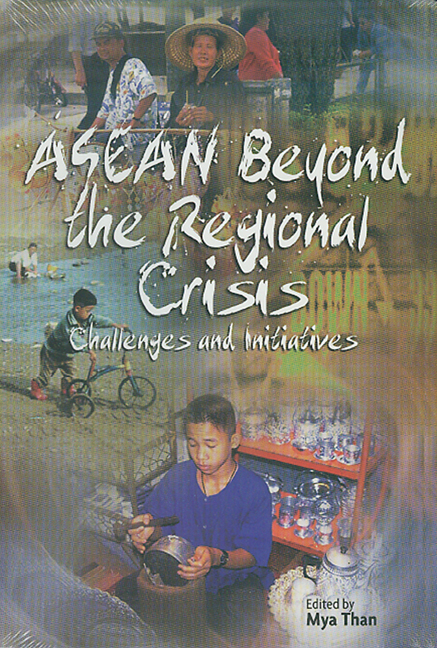Book contents
- Frontmatter
- Contents
- List of Tables
- List of Figures
- Glossary
- Contributors
- 1 ASEAN Beyond the Crisis: A Bird's-eye View
- 2 East Asia: Crisis and Recovery
- 3 Competitiveness and Sustainable Growth in ASEAN
- 4 ASEAN Free Trade Area: Progress and Challenges
- 5 ASEAN Investment Area: Progress and Challenges
- 6 Financial and Macroeconomic Co-operation in ASEAN: Issues and Policy Initiatives
- 7 Food Security in ASEAN
- 8 ASEAN Co-operation and the Environment
- 9 ASEAN and the International Trading System: Regional Trade Arrangement vs. the WTO
- 10 ASEAN and Its Inter-Regional Economic Links
- Appendix I ASEAN's Relevance: Has It Become Questionable?
- Appendix II Is ASEAN Still Relevant? Some Thoughts from a European Perspective
- Index
10 - ASEAN and Its Inter-Regional Economic Links
Published online by Cambridge University Press: 03 November 2017
- Frontmatter
- Contents
- List of Tables
- List of Figures
- Glossary
- Contributors
- 1 ASEAN Beyond the Crisis: A Bird's-eye View
- 2 East Asia: Crisis and Recovery
- 3 Competitiveness and Sustainable Growth in ASEAN
- 4 ASEAN Free Trade Area: Progress and Challenges
- 5 ASEAN Investment Area: Progress and Challenges
- 6 Financial and Macroeconomic Co-operation in ASEAN: Issues and Policy Initiatives
- 7 Food Security in ASEAN
- 8 ASEAN Co-operation and the Environment
- 9 ASEAN and the International Trading System: Regional Trade Arrangement vs. the WTO
- 10 ASEAN and Its Inter-Regional Economic Links
- Appendix I ASEAN's Relevance: Has It Become Questionable?
- Appendix II Is ASEAN Still Relevant? Some Thoughts from a European Perspective
- Index
Summary
Introduction
ASEAN was founded in 1967 with political motives and was not intended to be a cohesive economic entity or bloc. The ASEAN economies are mostly open in nature and as a consequence, they depend very much on economic relations with other countries outside the region. This is generally thought to be one of the key factors in both ASEAN's formation and its success. The Bali Summit in 1976 formalized the nature and structure of ASEAN's external political and economic relations, and these relations must be consistent with the following objectives:
a) To accelerate their efforts in improving market access for their raw materials and finished products outside the ASEAN region by way of seeking the elimination of all trade barriers in these markets, in developing new usage for these products, and in adopting approaches and actions in dealing with regional groups and individual economic powers;
b) To co-operate in the field of technology and production and improve the quality of exports and products, and to develop “new products” with the specific view of diversification of export products;
c) To adopt joint approaches to international commodity problems by way of the existing instruments with a view to contributing to the establishment of a New International Economic Order;
d) To give priority to stabilization and increase of export earnings of those commodities produced and exported by ASEAN through commodity arrangements, including buffer stock schemes and other means.
Three factors pushed ASEAN to seek extra-regional relations: economic, political, and the need to strengthen the evolution of ASEAN. The economic reasons were the most compelling. At the early stage of their development processes, the ASEAN countries depended on primary commodities, and they were thus very vulnerable to international price fluctuations. If ASEAN were to have closer relations with the developed countries, which were the biggest buyers of these commodities, then such co-operation would be a first step towards stabilizing prices. Most of the ASEAN economies adopted export-oriented industrialization as their engine of growth and for this they needed good export market networks. ASEAN was also the recipient of a large flow of foreign direct investment (FDI), in industries that assembled or processed imported intermediate goods to be exported back to the developed countries. Therefore, ASEAN needed close and cordial relations with the countries which were the sources of these investments.
- Type
- Chapter
- Information
- ASEAN Beyond the Regional CrisisChallenges and Initiatives, pp. 243 - 273Publisher: ISEAS–Yusof Ishak InstitutePrint publication year: 2001



